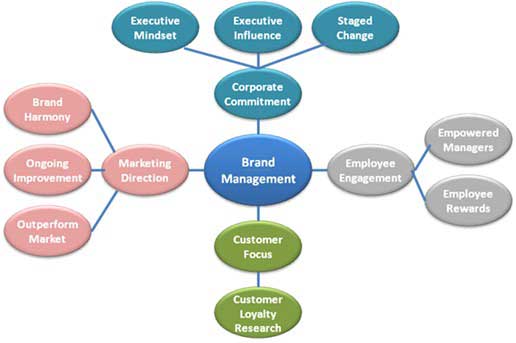Differentiating a brand in today's market requires expanding brand management from a traditional product, price, place, and promotion focus to a focus on experience as well.
A brand will stand out if it delivers its brand and customer promise in the context of the full customer experience—whenever and wherever the customer interacts with the product or service. Keeping customers, gaining new ones, increasing customer wallet share, and forging bonds with all customers are evidence of the success of the customer-experience focus.
Managing a brand for success requires commitment to a brand promise that is built around the way the customer experience affects customer behavior. Delivery of the brand promise must be both unique and consistent against the touch points that drive customer behavior. Why do customers buy? What is the influence of the point of sale (POS) and the salesperson? What is the balance between the cognitive (e.g., product quality) and the emotional (e.g., peace of mind) in customer decisions?
In this new flavor of brand management, Marketing needs to take a lead role to drive or influence the management of the customer experience across an organization.
Think about how you experience a product or service as a consumer—from decision through purchase and beyond, to customer service. You may start by seeking information online or from friends, acquaintances, or publications. You may monitor ratings and discussions on Amazon.com or eBay. When you decide from which company to buy, it's because you like what it offers, what it says, and what it stands for. Its image is complementary to your self-image.
Perhaps you receive a membership or special offers with your purchase. During the purchase process, you like the way you are treated; and if you deal with customer-service reps, they impress you with their knowledgeable answers to your questions, and perhaps they go to the next level, suggesting additional uses for the product you bought or additional ways to achieve your goals. That is the totality of the brand experience. Traditional marketing communication is just part of the full picture. Companies that lapse at any point in the customer experience can send the customer in search of a different brand.
Successful companies define the touch points (current or potential), identify the drivers of behavior, refine how each touch point reinforces the brand essence, and determine relative influences on behavior. Those steps enable such companies to deliver on both the drivers and the brand promise.
Consider Whole Foods Market and its extensive and growing customer base. Whole Foods focuses on food, health, the environment, and sustainability. Its brand promise and the touch points that drive its customer loyalty are harmonious with what Whole Foods represents. Accordingly, potential customers are attracted to the market and become long-term customers as well as brand advocates.
Delivering the brand as an essential element of the customer experience will differ from company to company, but the strategies to consider include those in the following graphic.

Corporate Commitment
Start with a strategy committed to an entirely new course that defines the brand according to a total experience dedicated to the customer. Online store Zappos is a good example. Rather than defining the company as an online retailer of shoes and accessories, the executive team built the culture based on the mindset that it is a customer-service company that happens to sell shoes.
Use the influence of the executive suite to coordinate improvements across functions. Customer loyalty is built via consistent brand performance—not by an isolated positive experience.
Stage organizational change. Reduce priorities to a manageable number (e.g., three key points per communication).
Customer Focus
Conduct customer research to identify loyalty drivers and determine improvements according to high-impact drivers.
Employee Engagement
Empower frontline managers with meaningful direction. Focus the entire organization on priority brand and loyalty drivers. Engage employees across all levels to be accountable for what happens during customer interactions.
Provide feedback, and reward employees who "live the brand."
Marketing Direction
Create harmony across the brand and customer strategies. Match brand and customer strategy with business strategy. Again, think of Whole Foods and how it demonstrates what it stands for.
Make delivering the brand an exercise in ongoing improvement and differentiation. Don't get caught napping after your initial success.
Run the business to outperform the market, and integrate brand and customer loyalty into business results.
* * *
Brand promise is the differentiator, but the consumer experience must be consistent from touch point to touch point. Unless all aspects are in sync, marketing dollars are not well spent and could result in negative equity because of a failed promise that could bring on customer backlash.



